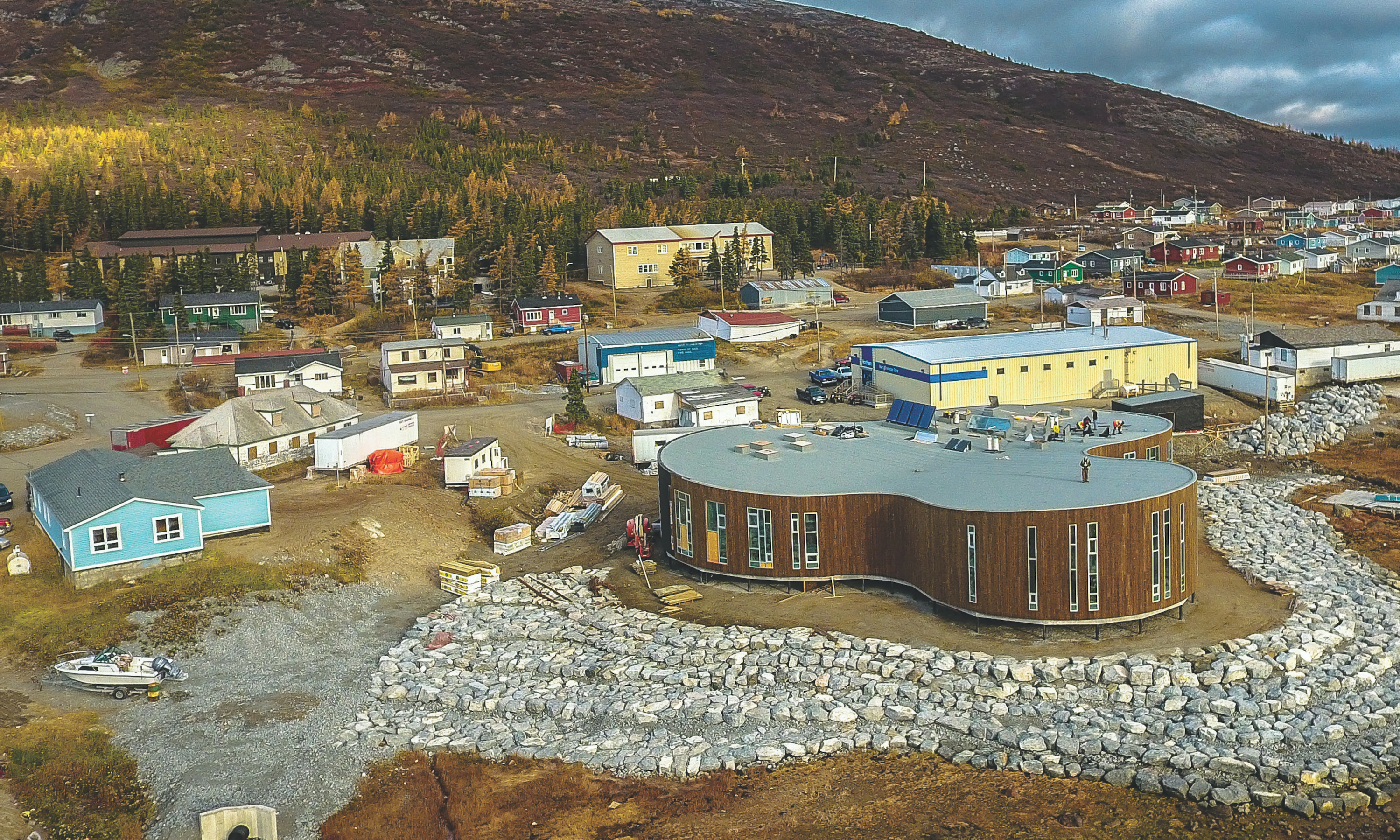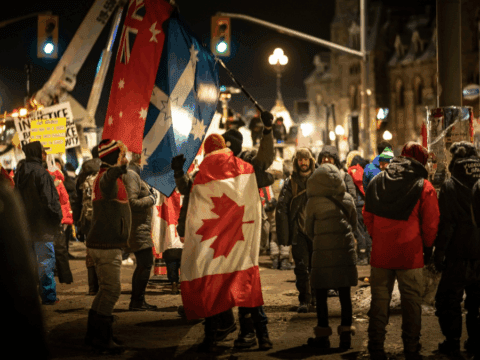Strolling around the coastal town of Nain, in northern Labrador, you’ll see rows of houses — red, turquoise, sky blue — arranged along ribbons of sandy roads. It’s late summer, and kids on bikes are racing one another while snowmobiles sit idle in front yards. A rockscape covered with a felt of lichen and studded with stunted spruce encircles the scene. It’s a familiar image to anyone who’s been to a fly-in- or boat-in-only community up north.
But after you walk past the fish processing plant, you’ll see a building that sticks out from the pattern of rectangular homes, government offices and Northern Stores (the go-to for groceries). There, hugging the water’s edge, is a structure that takes the shape of a clover leaf, its undulating walls mimicking the curve of the shoreline.
You may unsubscribe from any of our newsletters at any time.
This is the Illusuak Cultural Centre. While its avant-garde architecture might come as a surprise, the centre, whose construction was completed in 2018, is very much of this place — and of this moment. It symbolizes a new way forward for Nunatsiavut, the self-governing region of the Labrador Inuit, and it serves as an emblem of a cultural revolution.
“Illusuak is hugely exciting,” says Heather Igloliorte, an Inuk scholar and independant curator. Igloliorte is an associate professor and research chair in Indigenous art history and community engagement at Concordia University in Montreal, and she says the Illusuak Cultural Centre is “a real opportunity to tell our story.”
The centre will showcase Labrador Inuit heritage by hosting exhibits, performances and more. Its aim is to build pride among the Inuit by making their culture more visible to themselves and to visitors.
In Nain and throughout Nunatsiavut — Canada’s southernmost Inuit region — the Inuit are taking the future into their own hands by reclaiming their heritage. They are relearning traditional skills, reviving their dialect of Inuktitut (nearly lost as a result of government-run, English-only residential schools) and strengthening their musical traditions. They’re digging up archeological sites and recording history. And they’re busy creating art that honours their inherited craft techniques but also forges new traditions. With Illusuak in Nain, the region’s largest hamlet, all these creative enterprises will share a common space.
This cultural boom is a recent phenomenon, but the revival has its roots in the decades-long fight that secured land rights, political recognition and self-determination for the Labrador Inuit. “As a people, we have political and economic sovereignty,” Igloliorte says. “Now, we’re building cultural sovereignty.”

Inuit have thrived in the Arctic for thousands of years, but it was only in the late 15th century that they permanently settled sub-Arctic Labrador, setting up semi-nomadic camps for hunting and fishing through the seasons. In 1771, missionaries from the Moravian Church, a German Protestant denomination, established themselves in Nain, building a church and a trading post for fish and fur sold to European markets. Other Moravian missions soon followed along the Labrador Sea, and by the early 19th century, pretty much every Inuk in Labrador had been converted to Christianity.
The Moravians translated the Bible and German choral music into Inuktitut and used them to help teach the Inuit to read and write. But far more was lost. “We were no longer allowed to practise our own beliefs,” says Igloliorte. The missionaries banned shamanism, drum dancing and throat singing. As the Moravians removed the Inuit from their semi-nomadic lifestyle and brought them to live in permanent settlements, the Inuit came to depend on the services, including schools and stores, offered at the missions. Gradually, hunting and other skills expressive of a culture and necessary for survival in the north began to fade.
Compounding the issue, the existence of the Labrador Inuit was not recognized when Newfoundland and Labrador entered Confederation in 1949, Igloliorte says. So when the federal government decided in the 1950s to foster economic development in the Arctic by promoting Inuit art and support printmaking and stone carving co-ops, the money went exclusively to Inuit in the Northwest Territories (now Nunavut).
“People wrote about Inuit Moravians in Labrador as having given up their culture and not being authentic,” says Igloliorte. “At the same time, Inuit across the Arctic had already been converted to Christianity, but that was swept under the rug to promote . . . something exotic.”
Essentially, Labrador Inuit were seen as less Inuit than their counterparts in the Arctic, whose exoticism — real or exaggerated — was used as a marketing tool. The effect was that up until recently Labrador Inuit artists have worked in isolation with little or no funding.
Now that’s beginning to change, and many point to the signing of the Labrador Inuit Land Claims Agreement, which formally recognized Nunatsiavut as a self-governing Inuit region, as the catalyst for the cultural revival currently underway. The agreement took decades to negotiate and came into force on Dec. 1, 2005. It was on that day that the Nunatsiavut government sat for the first time in Nain, the newly minted administrative capital of the region, which also includes the communities of Hopedale, Makkovik, Postville and Rigolet.
“From the outset, the land claim was conceived to give Labrador Inuit control over their own territory and culture,” says Tom Gordon, a musicologist, professor emeritus at Memorial University of Newfoundland and a longtime researcher of music in Labrador. He says the new Inuit government was initially preoccupied with monitoring land development and resources, but has since been able to turn to the protection, promotion and encouragement of Inuit culture as well. “The cultural renaissance going on right now is the logical next step in self-determination,” he says.
“I feel very proud of the young people in Nunatsiavut who are taking back our culture. We are here, and we’re not going anywhere”
One art form that’s flourishing in Nunatsiavut is music. The Labrador Inuit possess a unique musical tradition combining Moravian and Indigenous influences, and they are now pushing that tradition in new directions. Unlike most other Protestants, the Moravians brought with them such an elaborate music tradition that by the 1820s there were choirs with up to 40 people singing Mozart, Haydn and Bach in Inuktitut accompanied by their own string orchestras.
Over time, the missionaries became less involved, the Inuit musicians assumed leadership and the music was increasingly Indigenized. “It became Inuit music, with lyrics not merely translated but tweaked to reflect Inuit lives,” says Deantha Edmunds, an Inuk soprano.
In Nain, the Inuit have revived their tradition of community brass bands, another Moravian import. Dormant for about 20 years but re-established in 2013, the Nain Brass Band includes a rotating lineup of 10 musicians playing trumpet, trombone and euphonium. They’ve become a staple at church ceremonies, but they also perform at weddings, for visiting dignitaries and when cruise ships dock. They’ve performed in Germany, and they’ve got an album to their credit. “They’re a going concern,” Gordon says.
For Edmunds, who lives in Rothesay, N.B., this upswing in all-things cultural has allowed her to come closer to her own Indigenous heritage. Canada’s only classically trained Inuk singer (her father was from Hopedale), Edmunds has spent most of her life away from Nunatsiavut. She was born in Newfoundland, and her father moved the family around the world during his long engineering career.
The recent addition of the Inuit Moravian musical tradition to her classical western repertoire has allowed her to bridge the cultural gap. “Since my father passed away, this special music has helped me through the grieving process. It has allowed me to feel closer to him whenever I sing and share the Inuktitut arias,” she says. “They’re all I want to sing now.”
Moved by this sentiment, Edmunds got together with other singers and instrumentalists to record Pillorikput Inuit: Inuktitut Arias for All Seasons. The album was nominated in 2016 for an East Coast Music Award, the first classical recording to be nominated in the Aboriginal Artist category. Creating the album also inspired Edmunds to further explore her Indigeneity by writing her own lyrics and composing music. “I’m in my 40s,” she says, “and this is a way to finally own my identity.”

While some Inuit artists are comfortable with the Moravian influences on their culture, not everyone embraces the hybrid art forms that stem from colonization. There are those who fold the cultural influences of kablunaat (“white man”) into a broader colonial legacy whose consequences can’t be ignored. Many Inuit are still grappling with the negative effects — including poverty, alcoholism and self-doubt — of imposed culture, laws, religion and language.
Jason Sikoak, a visual artist born in Rigolet who now splits his time between Liverpool, N.S., and Montreal, uses art as a way to deal with the hurt inflicted by colonial governments, the church and residential schools. “Art gives people a voice,” Sikoak says. “Words escape me, but when I draw, I can express myself.” He draws a direct line between his parents’ experiences at residential schools and his own mental health issues, and says the works he creates in pen and ink are ways “to mend myself.”
Part of the healing process is to vent anger, as seen in The Crosses We Bear, a commissioned piece where Sikoak depicts a shaman with three crosses embedded in his back. In another piece, Sacrilege, he has drawn an Inuk man caught between the conflicts of shamanism and Christianity. If Sikoak’s work is seen as controversial, he’s made his point. “Something pretty doesn’t make people think or start a dialogue,” he says, realizing that the debate around the legacy of colonialism and religion might get more tense before it gets better.
Still, he is optimistic — for himself as an artist finding a market for his specific brand of creativity, but also for Labrador Inuit. “Since the settlement of the land claim, we are slowly moving away from governing ourselves according to southerners’ ways,” he says. “Drum dancing and throat singing are coming back, and I feel very proud of the young people in Nunatsiavut who are taking back our culture. We are here, and we’re not going anywhere.”
For many Nunatsiavut artists like Sikoak, art is a way to assert one’s existence. To make that possible on a wider scale, Igloliorte has curated and assembled a travelling exhibit called SakKijâjuk (Inuktitut for “to be visible”). SakKijâjuk began touring in 2016, bringing Labrador Inuit art and craft to galleries across the country. (Igloliorte puts craft at the same level as art. “For us, craft is perhaps even more important than art, because it incorporates knowledge passed down through generations,” she says.) The first comprehensive Labrador Inuit art show ever to leave the province, SakKijâjuk brings together 85 works created by 47 Labrador Inuit artists and artisans. It has been shown in St. John’s, N.L., Halifax and Winnipeg, and will continue to Regina and Windsor, Ont., this year.
In many ways, SakKijâjuk and the Illusuak Cultural Centre complement each other. While SakKijâjuk brings Inuit art across the country, Illusuak aims to provide a space for Inuit cultural heritage to flourish at home. “[The centre] will bring youth and elders together and teach the young people about our history,” says Jim Lyall, Nunatsiavut’s minister of culture, recreation and tourism. “It will make them see who they are. We’ve been thriving in this harsh climate for thousands of years and have all the reason to be proud.”
When it opens, the Illusuak Cultural Centre will be a celebration of Inuit culture, including eons-old traditions and knowledge that, as a result of colonization, were forbidden and nearly forgotten. It’s all about being seen. But it’s also about seeing. The centre is set to become a hearth around which Labrador Inuit can gather, literally and virtually.
This story originally appeared in the January 2019 issue of The United Church Observer with the title “Statement Piece.”














